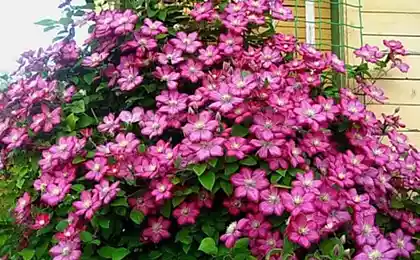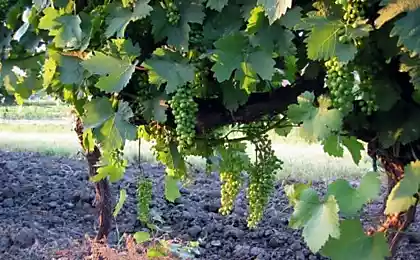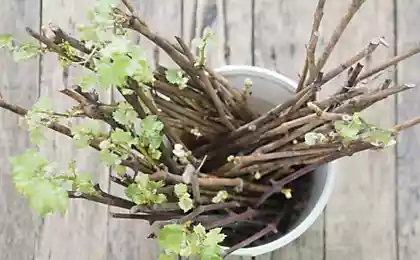737
How to prepare and save the cuttings for Scion

Grafting fruit trees and bushes — it is, like it or not, operation. And for operation it is necessary to prepare in advance: choose and prepare the "patient" — rootstock; collect necessary tools and materials; to procure the most important "authorities," which, being "sewn" should elevate a humble non-pedigree stock. These "vital organs" — cuttings. Or, in other words, periods of annual shoots from those trees that you intend to settle in your garden.
Everything seems to be easy and clear: cut the most beautiful escape from the right tree and you've got a cutting for grafting. But no — not everything is so simple... That's "Cherenkova" the subtleties and will be this article.
Big secrets little carunculatus that this piece sticks? But we also know that a tiny cut of the escape with 2-3 buds Nature has invested an amazing ability to give birth to a full new tree, giving it all the properties of the mother plant.

And if we decide to apply their hands to the creation of new varieties in my garden, harvesting this segment of stalk should be approached responsibly and with respect. Let's see what tell us the Nature and experience of growers.
What you should know when harvesting cuttings for grafting:
- Cuttings are cut from tested on the grade and yield is steadily the fruit-bearing trees and shrubs. In this case, the gardener knows exactly what he's going to instill on the base of the plant.
- For cuttings are selected well-ripened annual shoots.
- It is best to choose shoots from the outer parts of the trees, well lit by the sun.
- The best side of the tree from which to cut the cuttings from South. Shoots growing on the South side, have short internodes and well-developed eyes in the leaf axils.
- The best quality cuttings — shoots of the middle tier. The top shoots are too thick and powerful for the Scion, and the lower are characterized by little growth.
- Harvesting cuttings of cherry, it is necessary to keep in mind: at the annual cherry shoots a lot of flower buds, so you should select the shoots from young trees, where flower buds smaller, and make the cuttings longer, about 65-70 cm

Best handle-blank for the Scion looks like this:
- its length is 30-40 cm
- thick as a common pencil (7 mm)
- he has short internodes
- growth buds pronounced
- the number of buds developed — at least 4-5
- he was taken with the young fruiting wood (3-10 years)
Some advice from experienced growers
- Cuttings are best cut from trees that are regularly trimmed. These trees produce strong gains, with well formed apical and lateral buds.
- Shoots for cuttings try to take segment two year old wood, at least a small (1-2 cm) is such cuttings are perfectly preserved and well acclimatized.
- If the cuttings are cut from young trees not yet fully formed crown, it is necessary to cut them from the branches, which are scheduled in the spring to remove (so as not to harm the sapling itself).
- Vaccinations are not suitable for the thin, underdeveloped shoots with immature growth of the kidneys. In circumstances where there is no choice, it is better to use cuttings with growth the previous year, where there is a good growth buds.
- Cuttings are best preserved if the sections were processed garden pitch.
- The number of cuttings try to do a bit more than you need on the idea (suddenly not able to save them all).
As a rule, the cuttings of the Scion and then stored harvested during the year twice: in late autumn (early winter) and late winter (early spring).
Autumn (beginning of winter), Many gardeners prefer the autumn harvest. It is carried out after the end of leaf fall, when it "hit" the first major frost (about -15 C). The plants had already passed into a state of complete rest, the shoots have grown stronger, and along the way we saw a certain disinfection (fungi and microbes are killed from frost).
The meaning of autumn harvesting cuttings:
- annual shoots, which are taken for grafting, strong winter frosts will not freeze, and the gardener thus in advance has protected itself from risk to remain without grafting material.
- the stalk remains in the resting state, which occurred in the fall, to the point of inoculation. Because vaccinations are necessary for this "sleeping" stalk!

How to prepare the cuttings in the winter than it is to do and what to pay attention, says in the following video green thumb Alexey Malyshev
In winter (early spring)If in the fall the cuttings to procure not happened (and for aspiring gardeners it is very common, understandable and explainable ;), they can be cut now in late winter, and early spring. A lot of this need: a pruner, a little garden Vara or paint and good mood from what had decided the same and started!

In areas where winters are not too cold and the temperature does not drop below -20°C, problems with grafting material in General should not be. In these parts, the cuttings can be cut to any winter day.
If the winter was accompanied by strong frosts, it will be necessary to check whether the frozen shoots.
Latoma here for summer inoculations cuttings are cut directly into the time of the procedure. Here not only storage, but every minute of delay is undesirable.

Key tasks storage stick, it is also a story) why do we need to cut the stem a few months before vaccination, and then so long to store them? In order to "catch" a good time for the future of Scion: the buds on the shoot needs to sleep. And sleep until the day we will need — we do "awaken" them to the point of inoculation. Therefore it is very important to the day of vaccination to keep the cuttings dormant.
Let's look at the whole process of storing our cuttings step by step, from beginning to end.
Let's start with setting goals and objectives.
What we aim for, stacking the cuttings for storage
- To prevent the freezing of the cuttings
- To exclude the possibility of drying
- To save a state of complete rest
- To prevent access of rodents
- To prevent damage to cuttings
- Oh and don't forget/do not confuse, where some cuttings
For example, you can use wooden labels or cardboard signs, signed with a token/paste and pasted transparent stationery tape. Why two? More guarantee that will continue)
Alternatively, is this: my roommate's grandpa makes one label class, and the second number of the beam. And in my Notepad, notes 1 — Jonathan, 2 — snow kalvil [Apple]...
And to know how to perform all other tasks, go to the next section — on the rules of storage of the cuttings.
Where and how to store cheremissov long-term storage of rootstock material a lot — on the street, in the snow, in the building (basement, cellar, in an unheated room, on the veranda), in the refrigerator. Each gardener chooses the one that he is most accessible and convenient.
On the street (in the snow)In those regions of Russia where all the winter snow cover persists, the best place to store cuttings in the snow, in the snow piles.
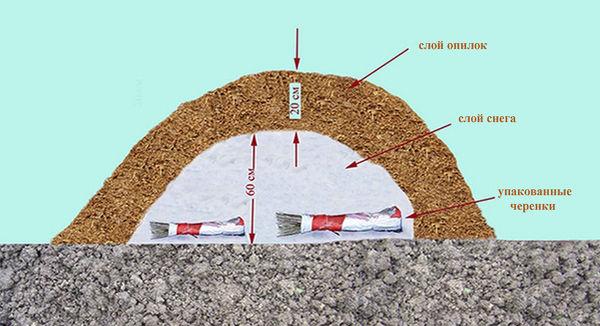
You can do this: dig up in dry, flood-free place a small trench to a depth of 30-35 cm, put it pine branches, to place the cuttings, cover again with coniferous spruce branches and covered with soil, sawdust, straw or leaves. The thickness of the snow cover over-educated storage during winter should not be less than half a meter.
You can not-ground in the ground, and store the compressed cuttings directly in the snow, also under a layer at least 50 cm Below the snow did not melt, it poured put sawdust or straw. So under the layer of snow cuttings, and will spend the winter.
With proper shelter heap, the temperature inside should be around 0°. If the cover is dense, temperature stable, despite the freeze and thaw. Storage of cuttings it is best to choose on the North side of the house (the barn) — there is snow cover would last longer.
From rodents cuttings can be secured by wrapping a layer of glass, plastic or metal chicken wire mesh or old nylon stockings/tights.
On the street (in sawdust)In the Western and South-Western areas where winter is often severe and prolonged thaws, when the snow stays wet, you can store cuttings in the frozen sawdust.
This is done as follows: on the North side of the house (outbuildings) harvested bundles of cuttings should be laid on the wet sawdust, the top is also wet sawdust to fill — and leave in the cold. After numerosity 15-20 cm layer, on top of this coma to put a layer of dry sawdust to 40 inches.
It need to cover with plastic wrap, which will prevent the workpiece from getting wet. In this state, the cuttings will remain in a frozen state until spring. A couple days prior to vaccination bale of cuttings can be made in the room where it will gradually thaw.
From rodents in this method of storage can be secured, sawdust moistened with clean water and solution karbolku or creoline (based 50-60 g per bucket of water). According to the gardeners, rodents circumvent this perfume side)
Below the bark is not wet when snow melts, you can put the cuttings in bulk plastic bottles with screw-caps, tubes, polypropylene pipes, or even just wrap bundles of multilayer cling film, leaving an air cavity.
In pogranupravleniya cuttings can be stored in a cold cellar. Old antiquated method...
There are several storage options: in the burlap, sawdust or sand, peat moss (sphagnum) or other substrate, a moisturizing.
In this case, the bundles of cuttings cuts down placed in dark plastic bags and sprinkled damp sawdust (good for softwood). Packages to tie tight do not want the cuttings to breathe.
In this case, bundles of cuttings are placed horizontally in boxes with holes (for ventilation) and covered with wet sand.
From novice gardeners often question: how to determine if there is sufficient moist substrate in which to store the cuttings, not too whether it is dry or wet. There is a simple folk test: you get a hand of the substrate (sand, sawdust, and so on), compress it in his fist, and, if moisture is there, but the water is not dripping — so the humidity is "suitable", the normal.
Storage of the cuttings in the cellar it is desirable to maintain a temperature of — 2°C to 0...+1°C Better, of course, the temperature was always 0°C and slightly below, but in the cellar, in addition to cuttings, stored and even vegetables and fruits, therefore it is hardly expedient to transfer the whole room into sub-zero mode. Temperature 0...+2°C — acceptable for all mode.
But for cuttings of grape temperature regime of storage is a little different: the optimum temperature for them is always slightly above 0°C. E.g. at a temperature of 0.4°With the shank easily stored until mid-March.
It is desirable to place the cellar thermometer to monitor and promptly control the temperature, avoiding any overheating or overcooling of the cuttings. When the temperature rises above +3°C may start swelling buds, and cuttings will be unfit for vaccination.
The humidity in the cellar should be at 65-70%. If the humidity needs to raise enough to put on a floor a bucket with water.
Please note! Experienced growers say that the storage in the cellar is suitable for cuttings seed crops and grapes, but sometimes gives poor results on stone fruits.
Home halogennitromethanes cuttings (and signed) must be placed in a clean plastic bag (or even two) and put in the fridge. If it is possible to set the temperature, well to put it no higher than +2°C. This storage option would be appropriate if the cuttings a bit.
All refrigerators are different, so the storage place you'll have someone right under the freezer, someone in the compartment for vegetables and herbs. The main thing — remember: the fridge and freezer is two different things. And the meaning of the cuttings storage — do not freeze them, and keep refrigerated!
Some gardeners suggest to put in the package a damp, clean cloth or even first, wrap the cuttings in moist cloth or paper and then pack in bags. This will help maintain the proper humidity.
Another option is cuttings separatelybut completely or only at the ends, then wrap in damp cloth or paper and placed in a plastic bag and tie tightly, leaving a small opening for air.
As a rule, in the lower compartment of the refrigerator, the temperature is around +2...+ 4 °C. Therefore, around the end of Feb to keep the cuttings in such conditions it is possible. But in March the buds are already starting to get under way in growth, particularly in stone-fruit species (plum, cherry plum, apricot and others), so to keep them in the refrigerator difficult.
Other "folk" ways granniesadult — people are resourceful and creative. Prepared cuttings they manage to save and hanging on the balcony (the veranda), and the window of a city apartment in the grid and hung on the tree. Of course, the cuttings are kept warm and wrapped in a clean package.

And some gardeners for "greater fidelity" store of valuable cuttings in large potatoes. Just stick the cuttings in it, is placed in the package — and cold!
So what's wit and cold calculation ("cold calculation" — it is just twice in the topic!) can significantly expand the boundaries of our horticultural features))
How to avoid damage to the cuttings during chraneneho can happen with grafting material for long months of storage? Yes anything: cuttings can become moldy, podupreti, wet or dry. In any of these cases, they will be unfit for vaccination.
It happens when exposed to low temperatures. Frozen cuttings for grafting is not suitable. To avoid this, you need to ensure that the cuttings under sufficient layer of snow (sawdust, leaves, land, etc.). Caution: never store the cuttings in the freezer!
Dry can frozen cuttings. Or shoots infected with fungal infections (moniliasis, for example). In the process of storage of the cuttings die and, of course, wither. To avoid this, you need to lay in store healthy material.
Can occur when due to excess humidity and low enough temperature the buds or cambium begin to emerge from dormancy. At this point they are practically defenseless against fungi and bacteria, which are rapidly penetrating the fabric. To avoid this, you need to follow the temperature regime and to prevent excessive humidity.
Occurs if the cuttings condensation — it triggers the development of mold on the crust. To prevent this, it is necessary to avoid condensation. At the first signs of mold you need to remove the condensate and to buy the cuttings in an aqueous solution of iodine alcohol (1%) or in 3% solution of copper sulfate.
If the cuttings are in water, they die from lack of oxygen.
Can occur if the ambient temperature is increased up to +4...+6°C. unfortunately, this indicates a failure of sprouted cuttings for grafting longer fit.
In any case, if the cuttings are kept in the room — the cellar or the fridge, veranda or balcony, — periodically (at least once in 3-4 weeks), you should check their condition. If you need to moisten the cloth, sand or sawdust, to clean up the mold and produce disinfection, correct temperature and so on.
When the time comes privivki grafting fruit trees usually begin in April (may), when the rootstock will begin active SAP flow. For successful coalescence of cuttings from rootstock is very important that the Scion was still alone, and the rootstock is already in the active state.
Therefore, the cuttings until the last moment kept in cold storage! And get them out of such shelters need not earlier than one day before inoculation. With the exception of those cuttings, which were stored in the frozen sawdust — they "go to light" all the frozen lump for two, and even three days, because the natural thawing is long enough.
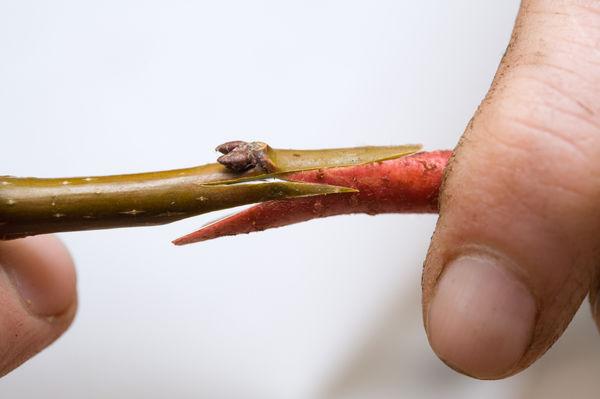
For reference. First grafted stone fruits (plums, cherries), pome fruits (Apple, pear). This is due to the fact that stone fruit crops, the SAP flow starts early.
How to check the condition of the cuttings
- The bark of the cutting on the species must be fresh and smooth. If it is wrinkled or looks dry — maybe stalk killed
- When bending the stalk should be firm and quite elastic. If when you try bending the stalk snapped and snapped — he winter did not survive
- When you cross cut the bared wood should be light green and fresh. If it's brown and barren — stalk for grafting is not necessary
- The kidneys should fit snugly on the handle (the escape)
- The scales of the buds on the form should be smooth to the touch — elastic
- When you cut the buds along the cut must be green (light green), without any brown inclusions
To determine whether not frozen, the cuttings, you need to test to make fresh cuts at the bottom and place in a container with clean water. If the cuttings are healthy and well kept, the water will remain transparent, and if they are frozen — the water will become yellowish-brown in color.published
Source: www.7dach.ru









